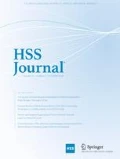Abstract
Electromyography (EMG) studies are a useful tool in anatomical localization of peripheral nerve and brachial plexus injuries. They are especially helpful in distinguishing between brachial plexopathy and nerve root injuries where surgical intervention may be indicated. EMG can also assist in providing prognostic information after nerve injury as well as after nerve repair. In this case report, a football player presented with weakness in his right upper limb after a traction/traumatic injury to the right brachial plexus. EMG studies revealed evidence of both pre- and postganglionic injury to multiple cervical roots. The injury was substantial enough to cause nerve root avulsions involving the C6 and C7 levels. Surgical referral led to nerve grafts targeted at regaining function in shoulder abduction and elbow flexion. After surgery, the patient’s progress was monitored utilizing EMG to assist in identifying true axonal regeneration.













Similar content being viewed by others
References
Sallis RE, Jones K, Knopp W (1992) Burners: offensive strategy for an underreported injury. Physician Sportsmed 20:47–55
Archembault JL (1983) Brachial plexus stretch injury. J Am Coll Health 31:256–260
Speer KP, Bassett FJ III (1990) The prolonged burner syndrome. Am J Sports Med 18:591–594
Levitz CL, Reilly PJ, Torg JS (1997) The pathomechanics of chronic, recurrent cervical nerve root neurapraxia. The chronic burner syndrome. Am J Sports Med 25:73–76
Barnes R (1949) Traction injuries of the brachial plexus in adults. J Bone Jt Surg Br 31:10
DiBennedetto M, Markey K (1984) Electrodiagnostic localization of traumatic upper trunk brachial plexopathy. Arch Phys Med Rehabil 65:15
Warren RF (1989) Neurologic injuries in football. In: Jordan BD, Tsairis P, Warren RF. Sports neurology. Aspen, Rockville, MD, Aspen pp 235–237
Hershman EB (1990) Brachial plexus injuries. Clin Sports Med 9:311–329
Sunderland S, McArthur RA, Nam DA (1993) Repair of a transected sciatic nerve. A study of nerve regeneration and functional recovery: report of a case. J Bone Jt Surg Am 756:911–914
Berenberg RA, Forman DS, Wood DK et al (1977) Recovery of peripheral nerve function after axonotomy. Effect of triiodothyronine Exp Neurol 57:349–363
Forman BS, Berenberg RA (1978) Regeneration of motor axons in the rat sciatic nerve studied by labeling with axonally radioactive protein. Brain Res 156:387–436
Herbison GJ (1984) Neuropathic Needle Examination. AAEM Course A: fundamentals of EMG. American Association of Electrodiagnostic Medicine, Rochester, MN, pp 21–25
Wohlfart G (1958) Collateral regeneration in partially denervated muscles. Neurology 8:175–180
Feinberg JH (2006) EMG myths and facts. Hospital for Special Surgery Journal 2:19–21
Author information
Authors and Affiliations
Corresponding author
Rights and permissions
About this article
Cite this article
Feinberg, J.H., Radecki, J., Wolfe, S.W. et al. Brachial Plexopathy/Nerve Root Avulsion in a Football Player: The Role of Electrodiagnostics. HSS Jrnl 4, 87–95 (2008). https://doi.org/10.1007/s11420-007-9064-1
Received:
Accepted:
Published:
Issue Date:
DOI: https://doi.org/10.1007/s11420-007-9064-1




